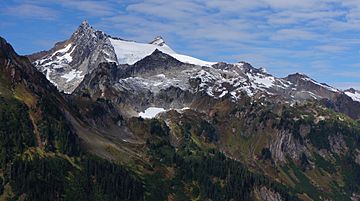Clark Mountain (Washington) facts for kids
Quick facts for kids Clark Mountain |
|
|---|---|

Clark Mountain
|
|
| Highest point | |
| Elevation | 8,602 ft (2,622 m) |
| Prominence | 1,522 ft (464 m) |
| Geography | |
| Location | Chelan County, Washington, U.S. |
| Parent range | Cascade Range |
| Topo map | USGS Clark Mountain |
| Climbing | |
| Easiest route | class 3 |
Clark Mountain is a tall peak in the Cascade Range in Washington state, USA. It stands at 8,602 feet (2,622 m) high. This mountain is part of the Wenatchee National Forest. It is the highest point in the Dakobed Range. Clark Mountain is about 8 miles southeast of Glacier Peak. You can find two glaciers on its slopes: the Richardson Glacier to the northeast and the Clark Glacier on the east side. Another peak, Luahna Peak, is just over a mile to the northwest.
Understanding Clark Mountain's Geology
The area around Clark Mountain, known as the North Cascades, has very rugged land. You can see sharp peaks, tall spires, long ridges, and deep valleys carved by glaciers. These amazing shapes were created by geological events that happened millions of years ago. These events also led to big changes in height and different climates across the Cascade Range.
How the Mountains Formed
The story of the Cascade Mountains began millions of years ago. This was during a time called the late Eocene Epoch. The North American Plate (a huge piece of Earth's crust) slowly moved over the Pacific Plate. This movement caused many volcanic eruptions.
Also, small pieces of Earth's crust, called terranes, came together. These pieces were from both the ocean floor and continents. They helped form the North Cascades about 50 million years ago. Imagine giant puzzle pieces slowly pushing together!
The Power of Glaciers
About two million years ago, during the Pleistocene period, something else shaped the land. Huge sheets of ice, called glaciers, moved across the landscape many times. As they moved, they scraped away rock and left behind piles of rocky debris.
This movement of glaciers created the "U"-shaped valleys you see today. The combination of land being pushed up (a process called uplift) and cracks forming in the Earth (called faulting), along with glaciation, made the tall peaks and deep valleys of the North Cascades.




